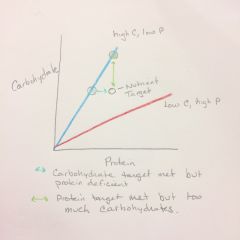![]()
![]()
![]()
Use LEFT and RIGHT arrow keys to navigate between flashcards;
Use UP and DOWN arrow keys to flip the card;
H to show hint;
A reads text to speech;
20 Cards in this Set
- Front
- Back
|
Amphibolic |
Krebs cycle Both catabolic and anabolic |
|
|
Calorie |
Amount of energy required to raise the temperature of 1 kg of water by 1 degree Celsius. Measure of potential stored energy. |
|
|
What do we use stored energy for? |
Transport, movement, anabolic reactions, osmotic balance etc. |
|
|
Gross energy |
The total amount of energy that is present in something. (Available and unavailable) |
|
|
Protein |
Synthesis of cells components 5-15% of body's energy Source is important 9 essential amino acids |
|
|
Methionine |
Deficient in soy protein |
|
|
Lysine |
Deficient in corn protein |
|
|
Carbohydrates |
Stored as glycogen Can be used to produce ATP in the absence of O2 (unlike fats) Types: monosaccharides, disaccharides, polysaccharides (structural: starch, cellulose) |
|
|
Fats |
Largest energy source Lightweight Provides protection and insulation Involved in cell signaling |
|
|
MIA93 |
Most common laboratory diet Allows for labs to feed subjects the same diet to remove those variables. Problem: Protein source is not all the same. |
|
|
Nutritional geometry |

Animals in the wild adjust what kind of foods they eat to meet their nutrient target. |
|
|
Protein as an energy source |
Not ideal NH2 must be eliminated Higher energy cost Spare NADH |
|
|
Fats as an energy source |
The movement of fats throughout the body require complexing with proteins |
|
|
Cori Cycle |
Exercise causes glycolysis to beundergone in muscles. This produceslactate, which is sent to the liver. Inthe liver, lactate is converted into glucose, which is sent back out (includingback to the muscle). The ability to send out glucose isunique to the liver. |
|
|
Breakdown of proteins in the muscle |
Include transaminations that producealanine. This alanine is sent to theliver and converted to glucose. Costs energy. In the liver, the alanine must be deaminated,which produces urea. Urea can be toxic at significant levels. It takes 4 ATP to process this urea. There is a higher energy cost associated with using proteins forenergy than there is for using carbs or fats. You don’t go through fermentation using proteins, sparing NADH. |
|
|
Glucose-6-phosphatase |
The enzyme inthe liver required for glucose to be transported out of the liver. The muscles don’t have this. |
|
|
Glucose from fat |
Cutting the tails of fatty acids yieldsglycerol, which can be made into glucose. |
|
|
Glucose from glycogen |
Glycogen is a large branched structure. Glucose is cut off the ends of the branches. Glucose-->glucose-1-phosphate-->glucose-6-phosphate |
|
|
Glucagon |
Signals the conversion of glycogen to glucose. |
|
|
Fat vs. Sugar |
Decline in fat consumption did notcorrespond to a decrease in obesity. It did correspond to an increase inconsumption of carbs (refined sugars). |

